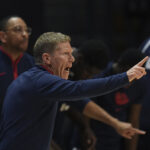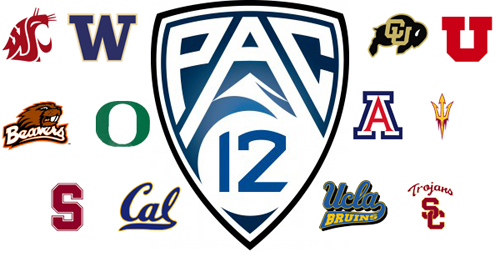As Pac-12 athletic departments close their books on the 2021 fiscal year — the year swallowed whole by COVID — the emerging picture covers an unprecedented range of outcomes.
Of massive deficits and small surpluses.
Of institutional lifeboats and carnage mitigation.
Only in FY2021 could an $18 million loss be considered a two-touchdown victory.
Nowhere was the sweep of outcomes greater than at the sister schools in the geographic heart of the conference.
Cal finished the 2021 fiscal year with a $3.5 million surplus, according to an audited statement of revenues and expenses obtained by the Hotline.
For the school of Powder blue, the bottom line was deep red. UCLA ended the 2021 fiscal year with a loss of $62.5 million, according to an unaudited statement of revenues and expenses obtained by the Hotline.
The Bruins are “developing solutions” to handle the debt.
“We’ve looked at our budget both from a revenue-generation standpoint as well as operational expenses and are developing solutions along with campus,” athletic department spokesperson Scott Markley told the Hotline.
“We have begun to enact many measures already, including with cost reductions and increased revenues from ticket packages and pricing.”
That’s a whopper of a shortfall, even in a year that was unlike any other. The pandemic, which had limited impact on bottom lines in FY2020, pummeled Pac-12 athletic departments in ’21 on several fronts:
— Negligible ticket revenue because fans were not allowed to attend football and basketball games.
— Greatly reduced media revenue because the conference only played half the football season.
— Depressed philanthropic support and reduced sponsorship revenue.
— Reductions in travel and recruiting expenses were offset by the cost of COVID testing. (UCLA spent $2 million directly on COVID testing and another $1 million on shared conference costs.)
As a result, many schools were relieved to close the year with shortfalls in the low-to-mid eight figures.
Colorado finished FY2021 with a $17.5 million loss, and a senior financial officer told the Boulder Daily Camera the shortfall constituted “a success story for as much as you can call it that, especially in comparison to our peers.”
Meanwhile, Utah finished with a $31 million loss — a victory compared to the $50 million shortfall the school projected for FY2021 at the outset of the pandemic.
The Utes used layoffs and furloughs to help keep expenses in check as revenues plunged. Even football coach Kyle Whittingham was subject to furlough. Other schools did the same. Some implemented salary cut, too.
In general, Pac-12 athletic departments took a greater hit than many of their peers in the ACC, Big 12 and SEC, where the football season was played in its entirety, fans were allowed in the stadium (albeit in reduced numbers) and media revenue approached normal levels.
(The SEC loaned each athletic department $23 million, an advance on a massive media contract the conference will sign with ESPN. The Pac-12 offered an internal lending program, as well, with only Colorado taking advantage.)
Because the Pac-12 played just half of a normal football season, the FY2021 media rights distribution from the conference office was approximately $22 million — or about two-thirds of what it would have been under normal circumstances.
Nonetheless, the disparity in bottom lines between Berkeley and Westwood is worth a deeper dive, largely because it reveals the stark contrast in the levels of institutional support — or lack thereof — each athletic department receives. Despite being part of the same university system, the campuses manage their money differently.
(As private schools, USC and Stanford are not required to make their financial reports publicly available.)
— The Bruins and Bears were more alike in their spending habits than their revenue generation in FY2021:
Cal reported $91 million in expenses, including approximately $8 million in debt service on the Memorial Stadium renovation project that is not booked as an operational expense but is included in the bottom line.
UCLA reported $110 million in expenses, including $9.3 million in debt service, leases and rent that is considered an operational expense.
The manner in which the campuses treat facilities couldn’t be more different.
Cal’s athletic department is responsible for only 45 percent of the annual $20 million (approximate) in debt service payments on the stadium renovation, a project rooted in seismic concerns. The remainder of the debt service is covered by campus.
Meanwhile, UCLA’s athletic department has to pay what the school described as a “usage fee” for Pauley Pavilion. That’s right. The hallowed arena with 11 national championship banners is operated by UCLA Recreation.
It’s an unusual arrangement, especially given that the athletic department was responsible for raising the $136 million needed to renovate the building a decade ago.
In exchange for paying the usage fee, the athletic department receives a portion of the concessions and merchandise sales.
(Cal’s athletic department does not pay for use of Haas Pavilion.)
UCLA’s FY2021 expenses also included $12.6 million in administrative fees — custodial costs are part of the line item — compared to just $3 million in administrative fees for Cal.
In contrast to many other athletic departments across the conference, neither Cal or UCLA implemented furloughs or layoffs. However, Cal coaches and senior administrators took voluntary salary reductions.
— The greatest difference in handling of FY2021 finances between the two campuses came on the revenue side.
Cal reported $94.5 million in revenue while UCLA booked half that amount — just $47.7 million (slightly more than Colorado).
There, too, we see a disparity in levels of institutional support.
UCLA receives about $2.5 million annually in student fees and little else from central campus. All other booked revenue is generated organically from athletics.
Meanwhile, Cal’s revenue of $94.5 million includes a $20.1 million check from central campus — the result of a decision made by chancellor Carol Christ a few years ago to support athletics.
“I believe that our Intercollegiate Athletics program has great value for the Berkeley campus,” she explained in a letter to the Cal community.
The Bears are hardly the only school in the conference that supports athletics with eight figures annually in direct support or through student fees. Utah, which reported a $31 million shortfall, received about $11 million from campus.
Cal also listed $19 million in what it described as “other operating revenue.” An athletic department spokesperson described the booking as “a non-recurring, one-time payment from a sponsor” but declined to comment further.
Meanwhile, UCLA’s “other operating revenue” was a whopping $311,000.
So if you’re keeping score, that’s $39 million for Cal in booked revenue from outside athletics, compared to $3 million for UCLA.
Without the one-time payment, the Bears would have been in the red, not the black.
The Bruins’ revenue generation was undercut by the same issues that affected every other school in the conference (ticket sales, media rights, etc.), plus one additional matter: Under Armour.
The apparel company unexpectedly ended its $280 million, 15-year contract with UCLA a few months into the pandemic, resulting in the loss of the $9 million cash payment the Bruins had been expecting for FY2021.
(Cal is immersed in a legal fight with Under Armour but declined to provide details on the status of the $3.5 million annual payments.)
Said Markley, the UCLA spokesperson:
“The impact of the pandemic continues to be felt at collegiate athletic departments across the nation.”
At some schools more than others.
Support the Hotline: Receive three months of unlimited access for just 99 cents. Yep, that’s 99 cents for 90 days, with the option to cancel anytime. Details are here, and thanks for your support.
*** Send suggestions, comments and tips (confidentiality guaranteed) to pac12hotline@bayareanewsgroup.com or call 408-920-5716
*** Follow me on Twitter: @WilnerHotline
*** Pac-12 Hotline is not endorsed or sponsored by the Pac-12 Conference, and the views expressed herein do not necessarily reflect the views of the Conference.
Related posts:
 Business of Sports – Former Fox Sports president skeptical that Big Ten move would make sense for Washington, Oregon, Bay Area schools
Business of Sports – Former Fox Sports president skeptical that Big Ten move would make sense for Washington, Oregon, Bay Area schools

Gonzaga head coach Mark Few (AP Photo/Gregory Bull)
Best of the West MBB power rankings: Gonzaga on top as Arizona slips, ASU climbs and Cal enters the scene VIDEO – Jon and Brad Cesmat chop up Arizona State heading to CFP
VIDEO – Jon and Brad Cesmat chop up Arizona State heading to CFP
 Mailbag: The super league and Pac-12 legacy schools, the Rose Bowl dollars, Pac-12 expansion, House case losers and more
Mailbag: The super league and Pac-12 legacy schools, the Rose Bowl dollars, Pac-12 expansion, House case losers and more
Jon Wilner
Jon Wilner has been covering college sports for decades and is an AP top-25 football and basketball voter as well as a Heisman Trophy voter. He was named Beat Writer of the Year in 2013 by the Football Writers Association of America for his coverage of the Pac-12, won first place for feature writing in 2016 in the Associated Press Sports Editors writing contest and is a five-time APSE honoree.
